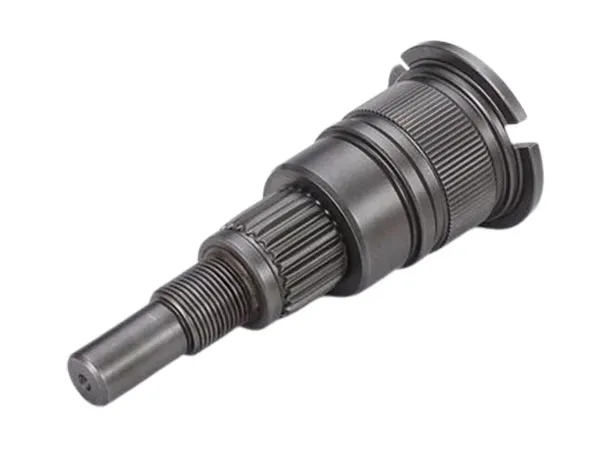- +86 13837949030 +86 15890619536
- info@lymcbearings.com export@lymcbearings.com
- Luoxin Industrial Cluster, Luoyang City,Henan Province,China

Worm gears are a type of gear mechanism used to transmit power between non-parallel shafts, typically at a 90-degree angle. They consist of a worm (a screw-like gear) that meshes with a worm wheel (a gear with teeth). Worm gears are known for their ability to provide high gear reduction in a compact design, making them suitable for applications requiring significant speed reduction and high torque. The worm is a helical gear with a screw-like thread that meshes with the teeth of the worm wheel. It provides the driving motion in the gear system. The worm wheel is a gear with teeth designed to engage with the worm. It transmits the rotational motion from the worm to the output shaft. Worm gears are valuable for their ability to provide high torque and significant speed reduction in a compact design. Proper selection, maintenance, and alignment are key to ensuring their optimal performance and longevity in various applications.
Worm gears are a type of gear system that consists of a worm (a screw-like gear) meshing with a worm wheel (a gear similar to a helical gear but with curved teeth). They are used to transmit torque and motion between two non-parallel, non-intersecting shafts, usually at a right angle. Worm gears are known for their ability to provide high gear reductions in a compact form, making them suitable for various applications that require large speed reductions and torque multiplication.
Characteristics of Worm Gears
Worm and Worm Wheel: The worm is typically a cylindrical gear with screw-like threads, while the worm wheel is a gear with teeth that mesh with the worm's threads.
High Gear Ratio: Worm gears are capable of achieving high gear ratios in a single stage (up to 100:1 or more), which is useful for applications requiring significant speed reduction.
Compact Design: The compact arrangement of worm gears allows for significant space savings in mechanical systems, especially where space is constrained.
Self-Locking Capability: Depending on the lead angle and friction between the worm and worm wheel, worm gears can have a self-locking feature, meaning the worm can drive the worm wheel, but the worm wheel cannot drive the worm. This is advantageous for lifting and hoisting applications.
Smooth and Quiet Operation: The sliding contact between the worm and worm wheel teeth provides smooth and relatively quiet operation, which is beneficial in noise-sensitive environments.
Working Principle of Worm Gears
Worm gears work by having the worm (the driving gear) rotate, causing the worm wheel (the driven gear) to rotate as well. The threads of the worm gear mesh with the teeth of the worm wheel, and as the worm rotates, it "pushes" the teeth of the worm wheel in the direction of the worm's rotation. This engagement causes the worm wheel to rotate at a much slower speed than the worm, resulting in significant speed reduction and torque multiplication.
Types of Worm Gears
Non-Throated Worm Gears:
Characteristics: Have a straight worm and worm wheel without any throating (curved surface). The contact between the worm and worm wheel is limited to a single point.
Applications: Used in low-load and low-speed applications due to limited contact and higher wear rates.Single-Throated Worm Gears:
Characteristics: The worm wheel is throated, providing a concave surface that wraps around the worm, increasing the contact area between the worm and wheel.
Applications: Commonly used in moderate load applications, offering better strength and load-carrying capacity compared to non-throated types.Double-Throated Worm Gears (Hourglass Gears):
Characteristics: Both the worm and worm wheel are throated, providing a large contact area. This type provides greater strength, smoother operation, and can handle higher loads.
Applications: Used in high-load and heavy-duty applications, such as lifting systems and hoists.
Applications of Worm Gears
Lifting Equipment: Worm gears are commonly used in hoists, elevators, and conveyors where self-locking capability prevents the load from descending unintentionally.
Automotive Steering Systems: Found in the steering mechanisms of vehicles where smooth and controlled rotation is essential.
Conveyors and Material Handling: Used in conveyors and industrial machinery for reducing speed and increasing torque.
Tuning Devices: Used in tuning instruments like guitars and violins due to their precision and self-locking feature.
Packaging Machines: Applied in packaging and assembly machines where precise movement and high torque are required.
Advantages of Worm Gears
High Reduction Ratios: Worm gears can achieve high gear reductions in a single stage, making them ideal for applications that require significant speed reduction.
Compact and Space-Saving: The perpendicular arrangement of worm and worm wheel allows for a compact gear system, which is beneficial where space is limited.
Self-Locking: In certain configurations, worm gears are inherently self-locking, which is useful for safety in lifting and hoisting applications.
Smooth and Quiet Operation: The sliding action of worm gears allows for smooth and relatively quiet operation compared to spur or helical gears.
Shock Load Absorption: Worm gears can absorb shock loads due to the sliding contact between teeth, providing durability in certain applications.
Design Considerations for Worm Gears
Material Selection: Worm gears are often made from different materials (e.g., steel worm and bronze worm wheel) to reduce friction and wear. Proper material pairing is crucial.
Lubrication and Cooling: Adequate lubrication is essential to minimize friction and dissipate heat. Oil or grease is typically used depending on the application.
Lead Angle and Pitch: The lead angle and pitch of the worm must be designed to match the application requirements, affecting efficiency, load capacity, and self-locking ability.
Load and Speed Requirements: Worm gears should be selected based on the specific load, speed, and torque requirements of the application to avoid premature failure.